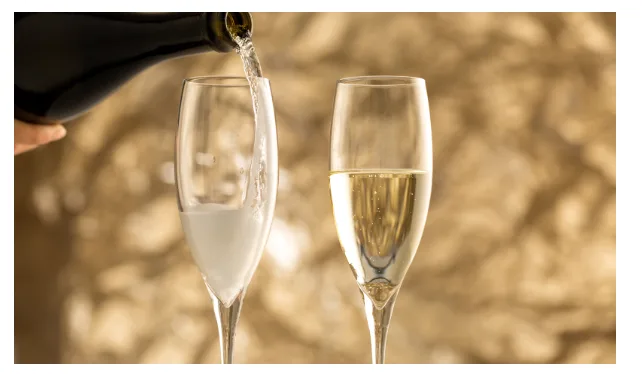Sparkling Wine vs Champagne: Which Is Healthier for Your Heart and Waistline?
When choosing between a glass of sparkling wine and a flute of Champagne, most people focus on taste, texture, or the celebratory mood it brings. But if you’re paying closer attention to your health, there’s another question worth asking—especially if you’re watching your sugar intake or trying to support your heart. While both drinks sparkle in the glass, the differences between them can quietly shape how they affect your body, from calorie count to cardiovascular impact.
So which is healthier for your heart and waistline? Champagne, particularly Brut or Extra Brut styles, is typically the better option. It’s lower in sugar, lighter in calories, and often made with red grape varieties rich in heart-supporting antioxidants. Traditional production methods give it finer bubbles and greater complexity, which may help reduce bloating and improve overall drinkability. Sparkling wines like Prosecco or entry-level blends often contain more residual sugar and fewer polyphenols, making them less ideal if you’re aiming for a cleaner, more health-conscious sip.
And if you’re opening a Champagne bottle to mark a meaningful moment, even the ritual itself can feel elevated. Customized Champagne sabers from brands like https://www.californiachampagnesabers.com/ turn the act of opening a bottle into a refined experience—one that honors the craftsmanship of what’s inside while making your toast more memorable. Knowing the difference in what you pour, and how you present it, helps you make smarter, more intentional choices—whether you’re celebrating big or winding down in style.
Champagne and Sparkling Wine Are Made Differently
The biggest health differences between Champagne and other sparkling wines begin at the production level. Champagne is made using the méthode traditionnelle, or traditional method, which involves a second fermentation inside the bottle. This process creates finer bubbles, more pressure, and a signature texture that defines true Champagne. The wine is then aged on its lees—spent yeast cells—which contributes to its complex flavor and may also enhance its antioxidant content.
Most other sparkling wines, such as Prosecco and many California varieties, are made using the tank method, also known as the Charmat method. In this process, the second fermentation occurs in a large stainless steel tank, not in the bottle. While this method is more efficient and cost-effective, it tends to produce wines that are lighter in body, fruitier in flavor, and lower in aging potential.
Why does this matter for your health? Traditional fermentation and extended lees aging result in higher levels of naturally occurring polyphenols, which are the same antioxidant compounds responsible for the cardiovascular benefits often attributed to red wine. Tank-fermented wines usually have less of this antioxidant activity, making Champagne a better option for heart-conscious drinkers.
Sugar Content Makes a Noticeable Impact
Sugar is one of the most important nutritional differences between sparkling wine and Champagne. Even small amounts of residual sugar can have a noticeable effect on your calorie intake, blood sugar levels, and metabolic response.
Champagne, particularly styles labeled as Brut, Extra Brut, or Brut Nature, contains very little added sugar. Brut Nature Champagne can contain zero to three grams of residual sugar per liter, which translates to a very dry and low-calorie profile. This is ideal for those monitoring their carbohydrate intake or aiming to avoid blood sugar spikes.
By contrast, sparkling wines like Prosecco often contain more sugar—even in styles labeled as Extra Dry. Despite the name, Extra Dry wines are typically sweeter than Brut. Some off-dry or semi-sweet sparkling wines can contain upward of 15 grams of sugar per liter or more, depending on how they are produced and what style the winemaker is targeting.
If your goal is weight management, blood sugar stability, or reduced inflammation, choosing a drier Champagne over a sweeter sparkling wine offers a significant nutritional advantage.
Calorie Counts Vary Based on Style and Method
Calories in wine come primarily from alcohol and sugar. Since Champagne is often lower in both, it tends to be the leaner choice. On average, a five-ounce pour of Brut Champagne contains about 90 to 100 calories. Wines with higher sugar content or alcohol volume may climb toward 120 or more calories per glass.
The production method also plays a role. Champagne’s longer fermentation and aging process generally leads to drier, more refined wines with lower sugar levels. In contrast, tank-fermented sparkling wines may prioritize flavor brightness and fruitiness, which often calls for higher residual sugar.
To minimize empty calories while still enjoying your drink:
- Choose Brut or Extra Brut styles
- Avoid sparkling wines labeled Extra Dry, Demi-Sec, or Sweet
- Check for alcohol by volume (ABV) and choose bottles closer to 11 or 12 percent rather than 13 or above
These small decisions can help you keep your caloric intake in check without giving up a celebratory glass.
Heart Benefits: Not Just for Red Wine Drinkers
Champagne and other traditional sparkling wines offer more than just bubbles. They contain phenolic compounds and flavonoids—antioxidants that have been studied for their potential to improve blood flow, support vascular health, and reduce inflammation.
Some specific benefits of moderate Champagne consumption may include:
- Improved endothelial function, which helps blood vessels relax and contract properly
- Reduced oxidative stress, which is associated with cardiovascular disease
- Better blood circulation due to mild vasodilation effects
These effects are more pronounced in wines made with red grape varieties like Pinot Noir, which is one of the three permitted grapes in Champagne. Because Pinot Noir is fermented with the skin in red wine production but pressed off quickly in Champagne, the resulting antioxidant levels are lower than in red wine but still meaningful—especially in traditionally made sparkling wines with lees aging.
Tank-method sparkling wines made from grapes like Glera, which is used in Prosecco, offer fewer polyphenols and usually undergo less aging. While still enjoyable, they may not deliver the same cardiovascular benefits as a well-aged Champagne or high-quality Cava.
Digestion, Bloating, and How Bubbles Feel
The type of bubbles in your glass doesn’t just affect appearance. It also influences how the wine feels in your mouth and how your body reacts to it. Champagne, thanks to bottle fermentation, has a softer mousse and smaller, more persistent bubbles. These are generally easier on the stomach and may help reduce bloating compared to sparkling wines with coarser carbonation.
Tank-fermented wines often have larger bubbles due to shorter fermentation and higher pressure inside the tanks. While refreshing, these bubbles can introduce more gas into the digestive system. If you’re prone to bloating or discomfort after fizzy drinks, Champagne may feel smoother and lighter overall.
Pairing bubbly with food also helps. Champagne’s high acidity makes it particularly food-friendly, supporting digestion and enhancing flavor while balancing fat and salt. This quality makes it easier to enjoy without overindulging or feeling weighed down afterward.
Cleaner Production and Fewer Additives
Regulations in the Champagne region are among the strictest in the wine world. This means Champagne is more likely to be made without unnecessary additives or excessive sweetening. Grower Champagnes, in particular, often emphasize minimal intervention, organic or biodynamic farming, and lower sulfite levels.
Some sparkling wines, especially those made for the mass market, may rely on sugar additions, flavor corrections, and industrial-scale techniques to maintain consistency. These wines can still be delicious, but they may contain more chemical residues or sugar than their traditional counterparts.
To choose a cleaner sparkling wine:
- Look for Champagne or traditional method wines labeled as organic, biodynamic, or low dosage
- Seek out smaller producers or grower labels, which tend to use fewer additives
- Avoid bulk sparkling wines with vague labeling or no mention of production method
Cleaner wines not only support your body better but also reflect a more transparent, intentional approach to winemaking.
Making a Healthier Choice: What It Comes Down To
When comparing Champagne and sparkling wine from a health perspective, Champagne tends to win in several key areas:
- Lower in sugar and calories
- Higher in polyphenols and antioxidants
- Gentler on digestion due to finer bubbles
- Less likely to contain additives or industrial ingredients
That doesn’t mean you need to splurge on Champagne every time. A well-made Cava or sparkling wine produced using the traditional method can also offer health-conscious benefits. The key is in reading the label, knowing the method, and choosing dry styles that prioritize balance over sweetness.
Smart Tips for Guilt-Free Sipping
Enjoying sparkling wine with wellness in mind is easier than you might think. A few simple habits can go a long way:
- Choose Brut, Extra Brut, or Brut Nature styles
- Sip slowly and stay hydrated with water in between glasses
- Pair with food to support digestion and alcohol absorption
- Avoid sugary mixers or Champagne cocktails when possible
- Stick to one or two five-ounce servings per occasion for maximum benefit
These habits help you enjoy every sip without sacrificing your health goals.
Whether you’re celebrating a milestone or simply unwinding, your drink of choice can align with your health priorities—if you know what to look for. Champagne offers elegance with fewer calories, lower sugar, and added antioxidant benefits, making it a strong option for heart-conscious and weight-conscious drinkers alike.
Not all sparkling wine is unhealthy, but the method, grapes, and sugar levels matter more than most people realize. With a bit of label literacy and some smart choices, you can raise a glass that supports your body as well as your spirit.
If wellness is your priority, choose bubbles that nourish as much as they delight.



